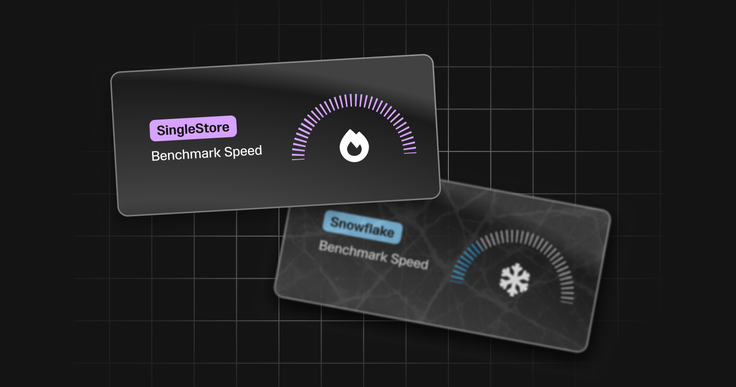You know that moment when your customer dashboard finally loads ... and everyone in the room pretends they weren't just staring at a spinning wheel for 15 seconds?
Or when your AI application delivers a response that's technically correct, but based on data from yesterday's batch job — which, in today's world, might as well be from the Mesozoic era.
If you're nodding along, you're not alone. Snowflake has revolutionized how thousands of organizations handle analytics, BI and data warehousing. It's brilliant at what it does. But here's the thing: the demands on our data have evolved faster than our architectures.The smartest teams aren't abandoning their Snowflake investments. They're doing something much more pragmatic: they're using the right tool for the right job.

The real-time performance gap (and why it's not going away)
Let's talk about what's actually happening in your data stack right now.
Your morning probably starts like this: Sales wants real-time analytics for customer insights. Product needs interactive dashboards that respond instantly. Your AI applications are hungry for fresh data to stay relevant. Meanwhile, your Snowflake bill keeps climbing as you throw more compute at workloads it was never designed to handle.
The symptoms are everywhere:
Customer dashboards that make users question their internet connection
AI applications serving up stale context
Warehouse costs spiraling as you scale up to meet real-time demands
Engineering teams building increasingly complex pipeline architectures just to get data "fast enough." Here's the uncomfortable truth: this isn't a Snowflake problem. It's a workload mismatch problem.
Snowflake excels at large-scale analytics, complex transformations and powering your BI dashboards. It's the MVP of data warehousing. But asking it to power millisecond-response customer or exec-facing applications? That’s like entering an 18‑wheeler in a Formula 1 race — phenomenal for hauling freight, hopeless for hairpin turns.
The modern approach: Snowflake + SingleStore + Iceberg
Forward-thinking organizations have figured out something elegant: instead of forcing one platform to do everything, they're building a purpose‑built data stack.
In this approach:
Snowflake stays in its lane, powering BI, batch analytics, historical reporting and model training — everything it was designed to dominate.
SingleStore becomes the real-time engine, offering high-speed ingestion, interactive SQL, millisecond responses and operational applications.
Apache Iceberg acts as the open bridge between the two.
Together, they create a complete solution, without the complexity of trying to make one tool do everything
Think of it as:
🏢 Snowflake = Analytical foundation → retrospective insight
⚡ SingleStore = Real-time layer → immediate action
Where speed actually matters (Spoiler: it's everywhere now)
Let's get specific about where this architecture shift makes the biggest difference:
Interactive customer dashboards: Your users expect sub-second responses, not "grab a coffee while it loads" responses. When your product dashboard needs to show real-time metrics, waiting for batch processing just isn't an option anymore.
AI and search applications: Whether it's retrieval-augmented generation, recommendation engines or intelligent search, modern AI applications need immediate access to fresh data. The context window for relevance is measured in seconds, not hours.
Customer-facing analytics: External users have zero patience for slow dashboards. Scaling Snowflake warehouses to meet these demands gets expensive fast — and still doesn't solve the fundamental latency issue.
Operational decision-making: Fraud detection, dynamic pricing, personalization — these workloads need data that's not just fast, but consistently fast. When milliseconds matter, architectural choice becomes a competitive advantage.
Playbook to add a real-time layer: It's easier than you think
"But," you're probably thinking, "this sounds like a massive architectural overhaul."
Plot twist: it's not.
Most teams are seeing dramatic improvements within just a few weeks. Here's what the typical path looks like:
Week 1-2: Identify the low-hanging fruit
Pick one or two high-impact use cases (usually customer dashboards or real-time alerts)
Map current data flows and pain points
Capture baseline performance metrics
Week 3-4: Set up the real-time layer
Turn on data sync: Snowflake ➜ Iceberg tables in object storage ➜ SingleStore (change‑data‑capture or external tables — your pick)
Build initial models / pipelines in SingleStore for your use cases
Validate connectivity and sub‑second freshness
Week 5-6: Deploy and validate
Launch real-time applications
Measure performance improvements (latency, concurrency and cost)
Gather user feedback (prepare for some happy surprises)
Ongoing: Expand based on results
Add more use‑cases (recommendations, fraud scoring, etc.) based on what's working
Optimize data flows and models
Roll up ROI and roadmap the next phase
The best part …
This isn’t experimental tech — hundreds of companies already run Snowflake + Iceberg + SingleStore in production.
Integration patterns are documented, SDKs and connectors are battle‑testedand the community is active.
Bottom line: With Iceberg acting as the open bridge and SingleStore delivering millisecond‑level speed, you can bolt a real‑time engine onto your Snowflake estate without a forklift rebuild — often in under six weeks.
Why this works (without breaking what you've built)
Here's what makes this approach so practical:
Your existing investments stay intact: Keep all your Snowflake reporting, BI dashboards, and analytical workflows exactly as they are. Nothing breaks, nothing needs to be rebuilt.
Familiar technology: SingleStore uses standard SQL, integrates with your existing BI tools, and doesn't require retraining your team. If you can work with Snowflake, you can work with SingleStore.
Proven patterns: The real-time data synchronization, the architectural patterns, the deployment strategies—other teams have already figured out the hard parts and documented the solutions.
Gradual adoption: Start with one use case, prove the value, then expand. No big-bang migrations, no rip-and-replace anxiety.
The outcome: Everyone wins
Teams that implement this architecture typically see:
10x faster dashboard response times (users actually enjoy using them again)
50% reduction in Snowflake compute costs by offloading inappropriate workloads
Weeks instead of months for new real-time feature development
Happier engineering teams spend less time fighting architectural limitations
Better user experiences translate to better business outcomes
And perhaps most importantly: you stop trying to make your data infrastructure do things it wasn't designed to do.
Ready to stop fighting physics?
If you're tired of waiting for dashboards to load, watching AI applications serve stale data or explaining why real-time features take months to build, it might be time for a different approach.
The solution isn't to abandon what's working — it's to complement it with what's missing.
Let's map out your specific situation and show you exactly how other teams solved similar challenges. In 30 minutes, we'll identify your fastest path to real-time performance and outline a practical implementation plan.
You’ll get a clear view of what's possible when you use the right tools for the right jobs.
[→ Schedule a Real-Time Architecture Review]
Check out the well-tested power of combining SingleStore and Snowflake your users shouldn't have to wonder if their internet is broken every time they open a dashboard.
Frequently Asked Questions












.png?width=24&disable=upscale&auto=webp)



